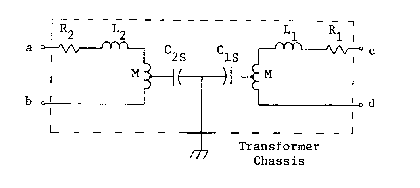
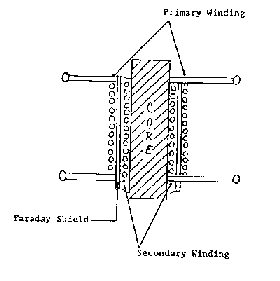
Figure 1 - Commercial Transformer Construction and Equivalent Circuit
Suppression of Powerline Noise with Isolation Transformers
Bruce C. Gabrielson and Mark J. Reimold
Sachs/Freeman Associates, Inc.
1401 McCormick Drive
Landover, MD 20785
Abstract
Isolation transformers have often been considered a "cure-all" for a plethora of grounding and power line noise problems. Contrary to popular opinion, isolation transformers cannot effectively isolate a circuit from noise caused by potentials between various system and common power grounds without the intelligent use of shielding and ground design. This paper describes the theory behind the isolation transformer, its physical and electrical characteristics and its proper application.
General Transformer Theory
All transformers provide isolation. They are generally constructed with a primary and secondary winding closely wrapped about the same ferrous core. Typical commercial transformers also incorporate a single Faraday shield between the primary and secondary windings to divert noise, which would normally be electrically coupled between the primary and secondary windings to ground as shown in Figure 1. The mechanism through which this electrical coupling of noise occurs is the capacitance between the coils of the primary and secondary windings of the transformer, which does not include a Faraday shield. This same capacitance limits the upper frequency bandpass of the transformer in much the same manner as the mutual and self-inductances of the device determine its low frequency cutoff. As the frequency of the exciting currents increases, the reactance caused by the capacitance between the windings, I/w C, tends to shunt these currents, thereby limiting high frequency performance.
The single Faraday shield controls all manner of evils which could be attributed to the electric coupling of noise through a transformer. However, the problem with a single shield arises when it is bonded to the ground of either the primary or secondary side of the transformer. The inclusion of a Faraday shield between the primary and secondary windings eliminates inter-capacitance, but it also establishes two new capacitances between the shield and both windings. These two capacitances allow high frequency currents to flow in the grounding systems of both the primary and secondary. Bonding the transformer shield to either the primary or secondary ground establishes current paths for high frequency noise in the reference conductor of the circuit to be isolated. The particular choice of ground for connection of the shield only provides selection of the quieter of the primary and secondary circuits. In many applications, this current path defeats any isolating effect, which a transformer might provide.


Figure 1 - Commercial Transformer Construction and Equivalent
Circuit
Isolation Transformers
An isolation transformer is designed to specifically address the problems associated with referencing its internal shields to ground. It is constructed with two isolated Faraday shields between the primary and secondary windings. When properly installed, the shield, which is closest to the primary winding, is connected to the common power supply ground and the shield closest to the secondary winding is connected to the shield of the circuit to be isolated. The use of two shields in the construction of the isolation transformer diverts high frequency noise, which would normally be coupled across the transformer to the grounds of the circuit in which they occur. The two shields provide more effective isolation of the primary and secondary circuits by also isolating their grounds. The isolation transformer adds a third capacitance between the two Farady shields, which may allow coupling of high frequency noise between the system grounds. However, increasing the separation between the two Faraday shields normally minimizes this third capacitance. Additionally, the dielectric effect of the shields plus the increased separation of the to windings significantly reduce the inter-capacitance between the windings. An equivalent circuit for an isolation transformer is presented in Figure 2.
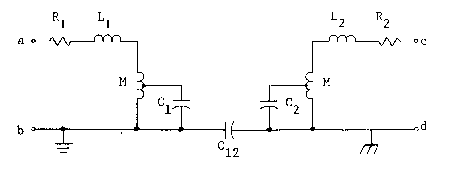
Figure 2. Equivalent Circuit of an Isolation Transformer
R1 = Resistance in Primary Windings
R 2 = Resistance in Secondary Windings
L1 = Primary Inductance Which Creates Leakage Flux
L2 = Secondary Inductance Which Creates Leakage Flux
M = Mutual Transformer Inductance
C1 = Capacitance Between Primary Windings and Primary Shield
C2 = Capacitance Between Secondary Winding and Secondary Shield
C12 = Capacitance Between Primary and Secondary Shields
Generally, a conductive foil completely enclosing the windings will provide a ground path for primary circuit noise and has the advantage that a very much smaller capacitance exists between primary and secondary coils than in the case of a simple Faraday shield. The Faraday shield is simply a grounded single turn of conductive nonferrous foil placed between coils to divert primary noise to ground. The enclosing shield, if grounded properly, will not re-radiate the noise signal, and will provide effective electromagnetic noise reduction. Typically, according to Topaz [1], at a distance of 18 inches from a transformer's geometric center, the field strength will be less than 0.1 gauss, and will roughly follow inverse cube laws.
Since inter-winding capacitances are the primary path by which significant powerline and transient related noise couples to the system, more information is needed to describe what occurs. During the time power is being transferred between transformer windings, noise potentials between the primary circuits and ground is similarly coupled to the secondary through both capacitive and resistive paths. This noise appears in three forms normally in a transformer circuit: common-mode, transversemode, and electromagnetic.
Common - Mode Noise
This noise appears between both sides of a power line and ground as shown in Figure 3. Since this noise is referenced to the power system ground, the most obvious method of eliminating this noise is by grounding the transformer center tap to the system ground via the lowest impedance path possible. Internal transformer designs, which separate the coils to reduce capacitive coupling, have some advantage, but it also increases leakage inductance and reduces the power transfer.
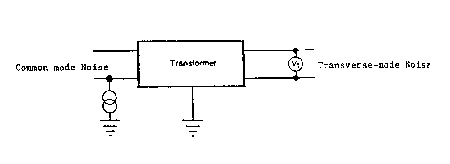
Figure 3. Common-Mode and Transverse-Mode
Noise
Transverse - Mode
Transverse-mode noise is much more difficult to eliminate than common-mode noise. The key to maximum noise reduction here, according to various sources [2], [3], [4], is to differentiate between power and noise, and then reduce the noise.
Noise and power are separated by the difference in their frequencies. The most effective transformer for the purpose is designed to be exactly opposite to a audio transformer. The objective is o transfer the power required by the load at the fundamental power frequency and to eliminate all higher and lower frequencies. Sub-harmonic frequencies are attenuated by operating the transformer at relatively high flux density, which is effective in reducing or eliminating them. Above the fundamental frequency, noise is reduced by introducing as much leakage inductance as possible, consistent with good power transfer to the secondary.
Transverse-mode noise appears as a voltage across both the primary and secondary windings of an isolation transformer. It occurs when a common-mode noise signal causes current to flow in the primary winding (or secondary winding), and from there to ground via capacitance to a grounded shield. Common-mode noise can also be transformed into 'transverse-mode noise, and thereby, through magnetic coupling, contaminate the secondary of an isolation transformer. Normally, by the proper selection of core loss verses primary winding inductance, a well-designed isolation transformer will eliminate the majority of this type of noise. Here again, grounding the transformer shield to the lowest impedance path available, will result in noise currents using this return path rather than some other higher impedance path to the noise source ground.
Electromagnetic Noise
Compared to common-mode and transverse-mode noise, electromagnetic noise does not constitute a major problem in most applications, but is sometimes critical in some recording or digital data systems, and in making electromagnetic interference measurements.
Box Level Applications
Because of the greater isolation achieved, isolation transformers are often used to protect high gain circuits, or prevent noisy ground paths in instrumentation. Shielding at the instrument level is difficult and often ineffective. Since most commercial instrumentation has single shielding in its power transformer, designers sometimes hope that by adding a second or primary shield (an isolation transformer), system ground problems can be eliminated. This approach often results in no benefits to the system unless all other ground paths in the instrument can be totally isolated. An isolation transformer is not a substitute for the proper shielding or grounding of individual instruments.
A typical transformer application at the box level is shown in Figure 4. The amount of ground isolation provided by the transformer at the box level is limited by the use of a single chassis shield enclosing the box. High frequency noise currents generated by the box circuitry can be coupled onto the circuit reference conductors through the connection of both transformers' shields to the circuit reference. Additionally, any potential difference between the power system ground at the isolation transformer primary input and the power system ground at the equipment and the power system ground at the equipment chassis will cause currents to flow in the reference conductor of circuitry.

Figure 4. Box Level Application of an Isolation Transformer
Rack Level Applications
The most effective application of isolation transformers is with racks of equipment. A rack acts as an outer shield for internal instruments, while serving as the zero-signal reference for system output signals. Isolation transformers are used to control shield currents, and to break up the mutual capacitance between rack instrumentation and an unknown power ground.
An isolation transformer application at the rack level is shown in Figure 5. The main benefit of using an isolation transformer with a rack of equipment is the enhanced control of currents in the equipment shields. Any potential differences between the utility power ground and the rack's ground will cause currents to flow in the loop 3 ---> 2 ---> 1 ---> 3 as indicated in Figure 5. The isolation transformer allows these "ground" currents to be directed through a portion of the rack's shielding which will not effect the operation of sensitive circuits and completely isolates these currents from the internal equipment reference conductors.

Figure 5. Rack Level Application of an Isolation Transformer
Room Level Applications
It is often necessary to isolate EMC test enclosures from noisy building grounds. Not only can isolation transformers be used to effectively decouple building power, but also since they also act as tuned circuits; they reduce the differential noise from external equipment, which reaches your screen room. While it is recognized a second isolation transformer inside the test room will greatly reduce power line ambient, this section will only consider using transformers on the power lines to a typical screen room.
As with any transformer, isolation transformers radiate magnetic fields. Physically locating the transformer adjacent to, or connected to, a screen room may increase rather than decrease ambient noise. Since the physical case of a transformer, as well as the primary winding shield, are normally connected to the third-wire power ground of the supplied power, the secondary winding shield must be isolated from the transformer case and connected only to the conduit shield going to the shielded room to achieve proper ground isolation. The conduit acts as an RF shield for the room's power and completes the connection between the shielded room and the secondary winding shield in the transformer.
If the transformer is three phase and supplies more than one room, the best application for isolation between rooms is to use only one phase for each room, with a limit of three rooms per transformer. With this approach, power line filters will effectively isolate the room while providing practical noise attenuation. The application of an isolation transformer at shielded room level is shown in Figure 6.
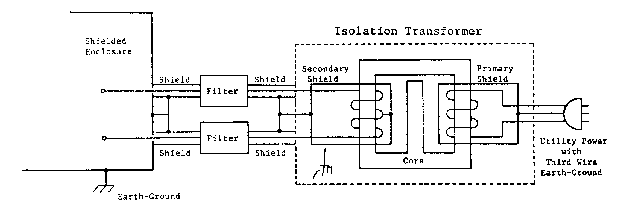
Figure 6 - Shielded Enclosure Application of an Isolation
Transformer
Conclusion
Proper transformer design, wiring, and, above all, grounding, are the only effective means of reducing the three types of noise problems. Grounding should be controlled and use the lowest impedance path possible (i.e., bonding) to the central reference ground system to insure maximum attenuation of noise sources. To achieve the maximum protection from a transformer, not only must it be applied properly, but also the transformer should be one specially designed for isolation usage.
References
1. Topaz Electronics, Noise Suppression Reference Manual, San Diego, CA, 1980.